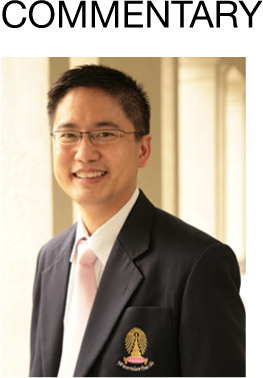It seems to be an exciting moment for the ASEAN countries to enter the era of the ASEAN Community. For the ASEAN 600 million people (8.6% of the World population), this regional initiative is expected to bring about economic prosperity and development in socio-cultural well-being of the people. However, development policies do not always complement one another as we promote economic growth and improve quality of life of the people. As part of the ASEAN Social and Cultural Community (ASCC) to promote equity in healthcare access across the region, the progress towards universal health coverage (UHC) becomes a key challenge. Different countries are at different stages of UHC development (Citation1). I agree with Hoang et al. highlighting three major constraints – including financial constraints, supply-side constraints and ongoing epidemiological transition. Nevertheless, the supply-side constraints, such as inadequate numbers of health workers, become my particular concern since the ASEAN Economic Community (AEC) movement includes promotion of different forms of trade in health services, ranging from exports of cross-border health care to migration of health professionals and direct foreign investment in the health sector. The liberalization of the health market raises demands for for-profit health services, competing for the same pool of resources needed for achieving UHC for the population of many ASEAN countries. Thailand, for example, has been facing a dilemma of promoting health services as an economic product under the medical-hub policy versus protecting health security of the people under the universal coverage policy. The growth of the private health sector has intensified competition in the labor market. The expansion of private health care has led to the rise in professional fees and salaries widening income gaps and causing the ‘Brain-drain’ problem in the public sector (Citation2). Several public hospitals have faced high turnover of health personnel, particularly physicians and nurses (Citation3).
The health coverage for migrants should also be focused. As the AEC would promote economic prosperity of the region, it could be expected that labor migration would continue. Cross-border health services and migrant workers – both documented and undocumented – could considerably increase service workloads for providers in the receiving countries. Although they might become income opportunities for some hospitals in certain well-to-do areas, the uninsured frequently result in uncompensated care in public hospitals (Citation4, Citation5). The situation also compromises access to care and, thus, potentially affects health of this segment of the ASEAN population. Despite some countries’ efforts to address the issue of migrants’ health coverage (Citation6), I foresee a long way to go – particularly for the undocumented migrants. The key question is ‘Who is, or are, going to pay?’ Some alternatives are compared and discussed in .
Table 1 Paying for health coverage of undocumented migrants
The ASEAN integration and its impacts on health services, particularly on health coverage for the population, is obviously a challenging situation. Given the diversity among the ASEAN countries, policies on health services and health coverage after the ASEAN integration should be carefully planned such that every nation can benefit. There are choices for approaching UHC in terms of whom to be covered, what services to be covered and at what level of payment. In light of the constraints, we may need building blocks and roadmaps that could align the region and each ASEAN country. Still, the key is collective commitment among the ASEAN members in income and wealth distribution, and health equity. To make it financially feasible for ASEAN, I would like to propose that ASEAN starts UHC with the coverage for selected basic health services for everyone, such as traffic accident and some epidemic-prone communicable diseases, rather than beginning UHC talk focusing on coverage for everything for selected groups, or UHC for all of the population. The step-by-step approach helps ensure the minimal standardized package of UHC for all ASEAN countries to address critical public health issues, allows for insurance portability, and makes it practical to manage reimbursement. This also helps address the issue of health coverage for undocumented migrants.
Author’s contribution
Conceptual development, literature review, manuscript writing and editing.
References
- Hoang VH, Pocock NS, Chaiyakunapruk N, Chhorvann C, Ha AD, Hanvoravongchai P. Progress toward universal health coverage in ASEAN. Glob Health Action. 2014; 7: 25856. http://dx.doi.org/10.3402/gha.v7.25856 .
- Wibulpolprasert S, Pachanee C, Pitayarangsarit S, Hempisut P. International service trade and its implications for human resources for health: a case study of Thailand. Hum Resour Health. 2004; 2: 10. [PubMed Abstract] [PubMed CentralFull Text].
- NaRanong A, NaRanong V. The effects of medical tourism: Thailand's experience. Bull World Health Organ. 2011; 89: 336–44. [PubMed Abstract] [PubMed CentralFull Text].
- Sriratanaban J, Charoenmukayananta S. Health Care Service Used by Lao Patients in Thailand: The impact on Thai public hospitals [In Thai]. Health Insurance Systems Research Office. Nonthaburi, Thailand: Health Systems Research Institute.
- Charoenmukayananta S, Sriratanaban J, Hengpraproma S, Trarathepb C. Factors influencing decisions of Laotian patients to use health care services in Thailand. Asian Biomed. 2014; 8: 665–71.
- Guinto RL, Curran UZ, Suphanchaimat R, Pocock NS. Universal health coverage in ‘One ASEAN’: are migrants included?. Glob Health Action. 2014; 7: 25749. http://dx.doi.org/10.3402/gha.v7.25749 .

